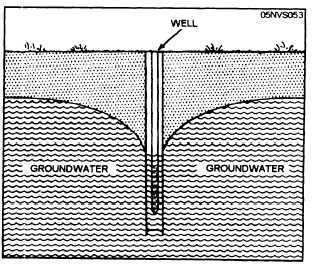surface area by the average depth. The answer is cubic feet. Multiply by 7.5 to obtain gallons at the water source. An example of this is a pond with an average depth of 7 feet and a surface area of 2,864 square feet. It is calculated as shown below:
Q= Ax D x 7.5
Q = 2,864 x 7 x 7.5
Q = 150,360 gallons
Lakes and ponds are usually located within the water table, and the hydraulics of the water feeding the lake or ponds are similar to that of wells. Therefore, a drawdown test, using a method similar to the one described below for wells, may be used to calculate the quantity of water. To perform the test, you should draw down the static water level to 1 or 2 feet and then record the recovery time. Also, devise a method to discharge the water being pumped so it does not return to the source during the test.
To calculate the quantity of water that can be supplied from newly constructed or existing wells, you must make a drawdown test. To perform this test properly, you must understand the hydraulics of a well.
Before being pumped, the level of water in a well is the same as the level of the water table in the water-bearing formation in which the well is completed. This is called the static level in the well and in the foundation. (fig. 9-1). The depth from the ground surface to the static water level should be measured and this distance used to describe its position. Thus if the water in the well

Figure 9-1. - Static water level before pumping.
9-2 is 25 feet below ground, the static water level is said to be 25 feet for this well. Elevation of the static water level above mean sea level can also be used to describe its position. When a well is pumped, the water level drops. After several hours of pumping at a constant rate, it stabilizes itself in a lower position. This is called the pumping level or dynamic water level for this rate of pumping (fig. 9-2).
The distance the water is lowered by pumping is called the drawdown. It is the difference between the static level and the pumping level. The drawdown in the well, resulting from pumping, lowers the water pressure in the well, but the surrounding water-bearing formation retains its original pressure. In response to this difference in pressure, water flows out of the pores of the formation into the well.
The water-bearing formation does not furnish its water all at once to the well being pumped. The flow of water into the well is held back by the frictional resistance offered by the formation to the flow of water through its pores. The resistance varies in each formation and is developed in direct proportion to the rate of movement or velocity of the water in the formation. The rate of flow, resulting from a given pressure difference, depends on the fictional resistance to flow developed in the formation. The term used to describe this characteristic of a porous material is permeability.
For a particular type of well, the yield of the well for any given drawdown is

Figure 9-2. - Pumping level.
Continue Reading